The following article from the Japan Times is notable for a number of reasons. Above all it shows how Shugendo is opening up to outsiders in dramatic fashion: rental clothing from a tourist office, and advertisements in English would have been unthinkable in times past. It can be seen partly as a response to falling numbers with a diminishing population, and partly as symptomatic of the way increased tourism in Japan, and increased spiritual tourism in particular, are having an impact on the country’s traditional practices.
It’s the feeling of Green Shinto that nature-worshipping Shugendo, despite being relatively little known in the West, provides greater opportunity for spreading internationally than Shrine Shinto, with its ties to physical buildings and the Japanese state. Though Shugendo is often associated with Buddhism, this article makes plain its strong Shinto allegiance too. In addition, the setting of Dewa Sanzan is most attractive and conducive to spiritual refreshment. Anyone looking for an enriching off-the-beaten-track experience while in Japan would be well advised to contact the links at the end of the article. (For previous Green Shinto articles on the subject, and Shugendo’s spread to the West, please see the category for Shugendo in the righthand column.)
Yamabushi: Japan’s ancient tradition of mountain ascetics opens to the public
BY KATHRYN WORTLEY. SPECIAL TO THE JAPAN TIMES OCT 13, 2017
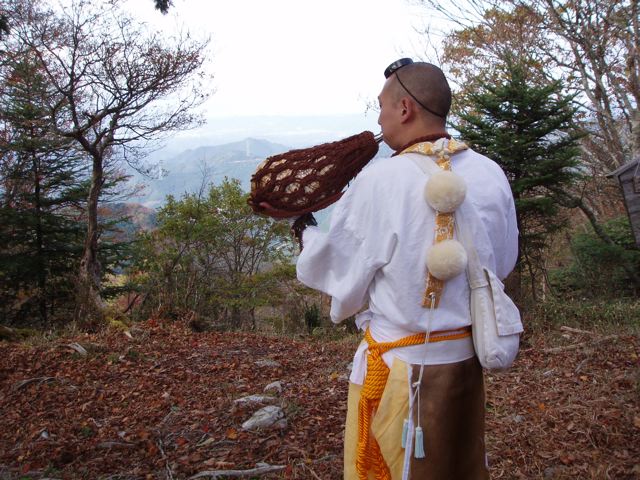
A yamabushi in full regalia, blowing the characteristic conch horn
“It suits you,” says another hiker, pointing at my headdress. “You look cute.”
“Um, thanks,” I answer, relieved that I’m not alone in being unaware of the outfit’s significance.
Since being dressed in it, I enthused about its novelty and surprising comfort until I discovered the somber meaning behind it: these clothes are designed to resemble robes worn by the dead.
By donning the garments, my group and I have symbolically given up our worldly impurities and are now to traverse the three holy mountains of Dewa, called Dewa Sanzan, in order to be spiritually reborn. Each mountain symbolizes part of that journey: Mount Haguro, the present; Mount Gassan, the past; and Mount Yudono, the future.
This is the teaching of the yamabushi, the followers of Shugendo, an ancient ascetic religion combining aspects of mountain worship, Buddhism, Shintoism and Taoism. Critical to their beliefs is the pursuit of enlightenment through convening with nature over long periods as well as feats of endurance such as waterfall bathing and walking over fire.
Dewa Sanzan, in Yamagata Prefecture, has been an important center for yamabushi since the beginnings of Shugendo in the eighth or ninth century, although it didn’t grow in popularity as a pilgrimage route for spiritual rebirth until the Edo Period (1603-1868). To this day, each yamabushi in good health is required to make the journey.
As practitioners have begun to open up their once-private world to outsiders, an increasing number of nonbelievers are joining them, from businesspeople seeking respite from the stress of modern living to tourists and expats keen to uncover a lesser-known part of Japanese culture. And some local residents in Yamagata are working to welcome such people to Dewa Sanzan.
We start our journey at the foot of Mount Haguro, the most famous and easily accessible ascent of the three. After passing through Zuishin-mon (the Gate of Dual Deities), which marks the start of our journey to spiritual rebirth, we descend stone steps to enter a thick forest. Given the multitude of small and intricately carved wooden shrines, each home to a huge variety of deities, it’s not long before the group fans out to explore. But our yamabushi master is soon blowing his giant conch, signaling us to gather at a bright-red bridge where we see a waterfall alongside a small shrine expertly blended into the forest.
Soon, we reach the oldest pagoda in Tohoku, which is regarded as one of the most beautiful pagodas in Japan. At 30 meters tall, a single column runs through it, but each of its five individual sections is entirely independent. According to our guide, this is the reason it became the structure on which Tokyo’s famed Skytree is based.
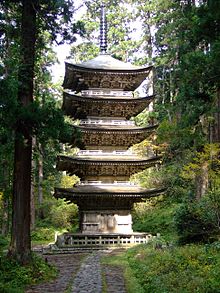
The five-tiered pagoda on Mt Haguro
Invigorated by the sight, we begin to climb, taking the first section of the 2,446-step stone stairway to the summit in our stride. With few other hikers to disrupt the sound of bird song and the breeze rustling through the 580 cedar trees that line the path, it’s a serene experience.
Passing under the trees gives a sense of the history of this journey. Most of the cedars are between 300 and 500 years old and, for ultra-perceptive visitors, 33 hand-done engravings can be found in the steps, which are believed to have taken 13 years to build. We find one that looks like a sake cup.
Such is the beauty of the cedar-lined path that it has been dedicated a significant natural monument and awarded three stars in the Michelin Green Guide Japan.
Halfway up, we stop at a rest station that has been run by the same family for three generations. Undeterred by the challenging location, they all pitch in to carry supplies up the mountain each day. They offer green tea, sweets and a sweeping view, and their cafe is only closed in winter when snow prevents access.
At the top, we receive our Shinto yamabushi blessing, comprising chanting, bell ringing and paper swaying, at the main shrine building of Sanjin Gosaiden before descending to our lodging in Toge, the town at the foot of the mountain. For centuries, homes draped with shrine ropes have welcomed pilgrims to the region with accommodation, shōjin-ryōri(vegetarian Buddhist cuisine) and even mountain guides.
The second peak of our journey, Mount Gassen, could not be more different than the first. Though known as “the mountain on which ancestors rest,” it’s noticeably devoid of religious artifacts apart from one shrine at its midpoint and another at its summit. Passing wetlands brimming with insects and alpine plants as we snake slowly up the mountainside, it is clear that nature gets priority here.
Our path consists of two parallel wooden beams that are raised off the ground to protect the delicate ecosystem and encourage the single-file movement of hikers. As the grasses encroach on the sides, it also proves a great way to camouflage the human impact on this almost 2,000-meter peak.
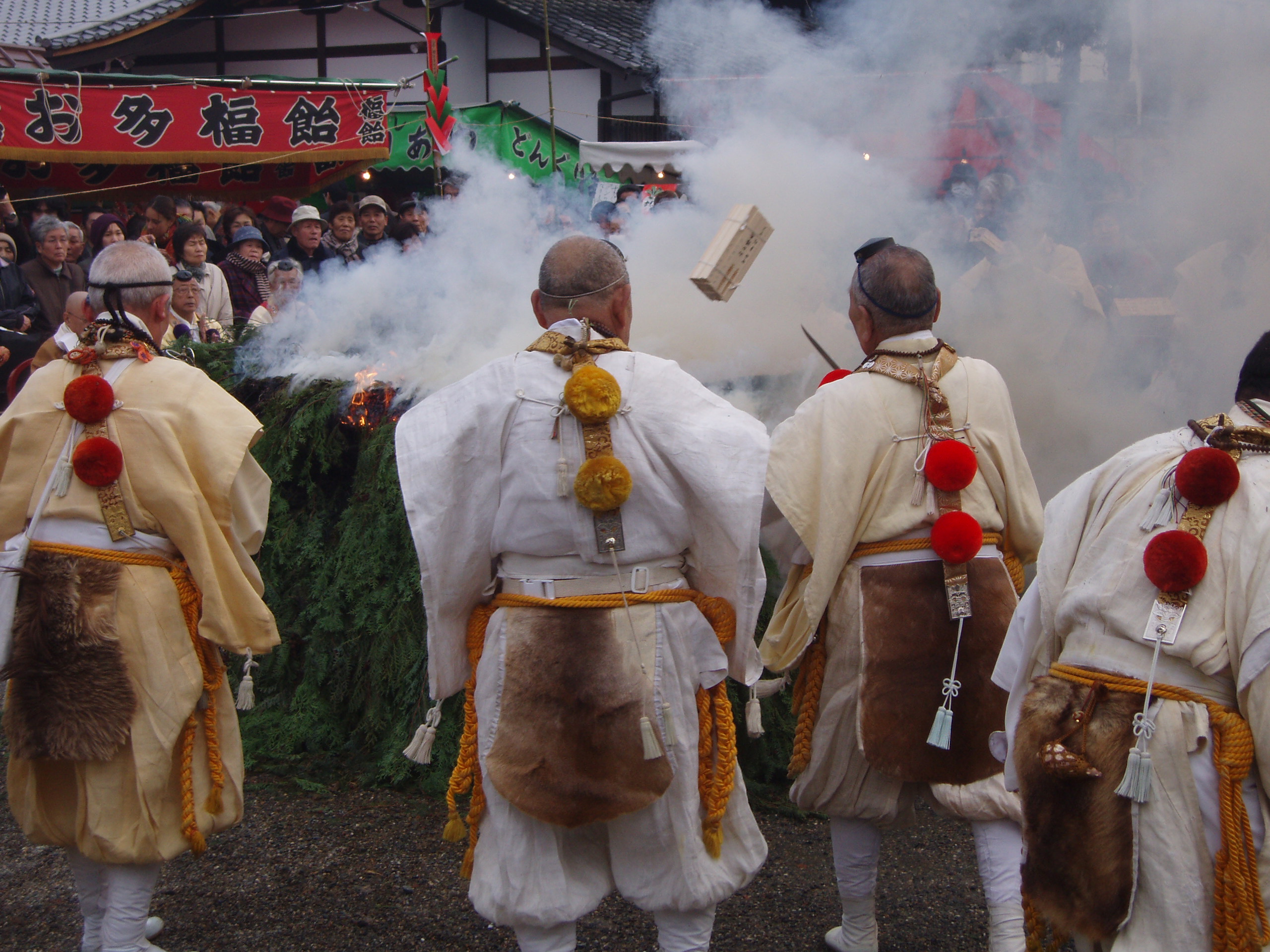
A Shugendo ritual fire ceremony in which prayers are sent up in the smoke to heaven. Shugendo was banned by the Meiji Reformists in 1872 and adherents forced to choose between Shinto and Buddhism. The ban was only lifted in 1947.
That feeling of being at one with nature appeals to our yamabushi guides. Their reason for spending so much time on mountains such as this one is to let the force of nature and the natural life force in their bodies drive them forward when they encounter problems in their lives.
“We leave ourselves in nature and make peace in our minds, feeling with our body to realize our senses,” explains Fumihiro Hoshino, a 13th-generation yamabushi master at whose lodging we stayed. “With a yamabushi mindset, we can restore ourselves and rejuvenate our lives.”
Women, he says, are more gifted at prioritizing feeling over thinking than men, who tend to focus on what they can see. This, along with the general decline in yamabushi across Japan, prompted Hoshino to welcome women to learn under him. Of the fresh faces at the outings, more than half are now women, he says. Another trend is the rise in participants from Japan’s biggest cities. This comes as no surprise to Takeharu Kato, a yamabushi who left his job at marketing giant Hakuhodo to found Megurun Inc., which offers yamabushi experience programs.
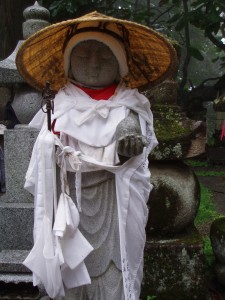
Jizo in his guise as a monk at Dewa Sanzan. Deeply syncretic, yamabushi offer prayers to Buddhist and Shinto deities alike.
“Yamabushi has been used for centuries to provide space for consideration of the challenges of life, an important role in the current age where people are becoming busier and busier and are looking for the chance to revitalize,” he said. “When we train, we are no longer restricted or distracted — even our watches are removed — and we don’t speak at all. We allow ourselves to be totally open to what the master is trying to show us through the natural world.”
Kato’s assertion that Shugendo has never been so relevant is food for thought as we set off to the last leg of our journey, Mount Yudono, which is so sacred that photography is not permitted past its giant torii.
About 10 minutes’ walk up the path, we reach a small booth where the priest instructs each of us to go barefoot bearing one human-shaped fine paper cutout. Only after rubbing it over our bodies and casting it into a small stream to rid ourselves of impurities are we allowed to enter a special secluded area. In its center is a giant reddish-brown rock, which is believed to contain a deity. Hot spring water spurts out and flows down its side, into which steps have been carved. Gingerly, we climb up the soaking rock to reach a small shrine overlooking the valley, where our journey of spiritual rebirth becomes complete.
Reflecting afterward in the nearby sacred foot bath, we agree that at the very least we will leave this place feeling energized. Our journey through Dewa Sanzan, experiencing the tranquility and beauty of the three diverse mountains, and having the privilege of a glimpse at this rare part of Japanese spirituality, has left more of an impression than any of us had expected.
Fly from Haneda Airport in Tokyo to Shonai Airport, or take a shinkansen to Niigata Station before changing onto a Limited Express Inaho train to Tsuruoka Station. Three- or five-day yamabushi training experiences are available at www.yamabushi.jp. Yamabushi clothes and guides can be rented for a day from Haguro Tourist Association on Saturdays from April to October: www.hagurokanko.jp/en.
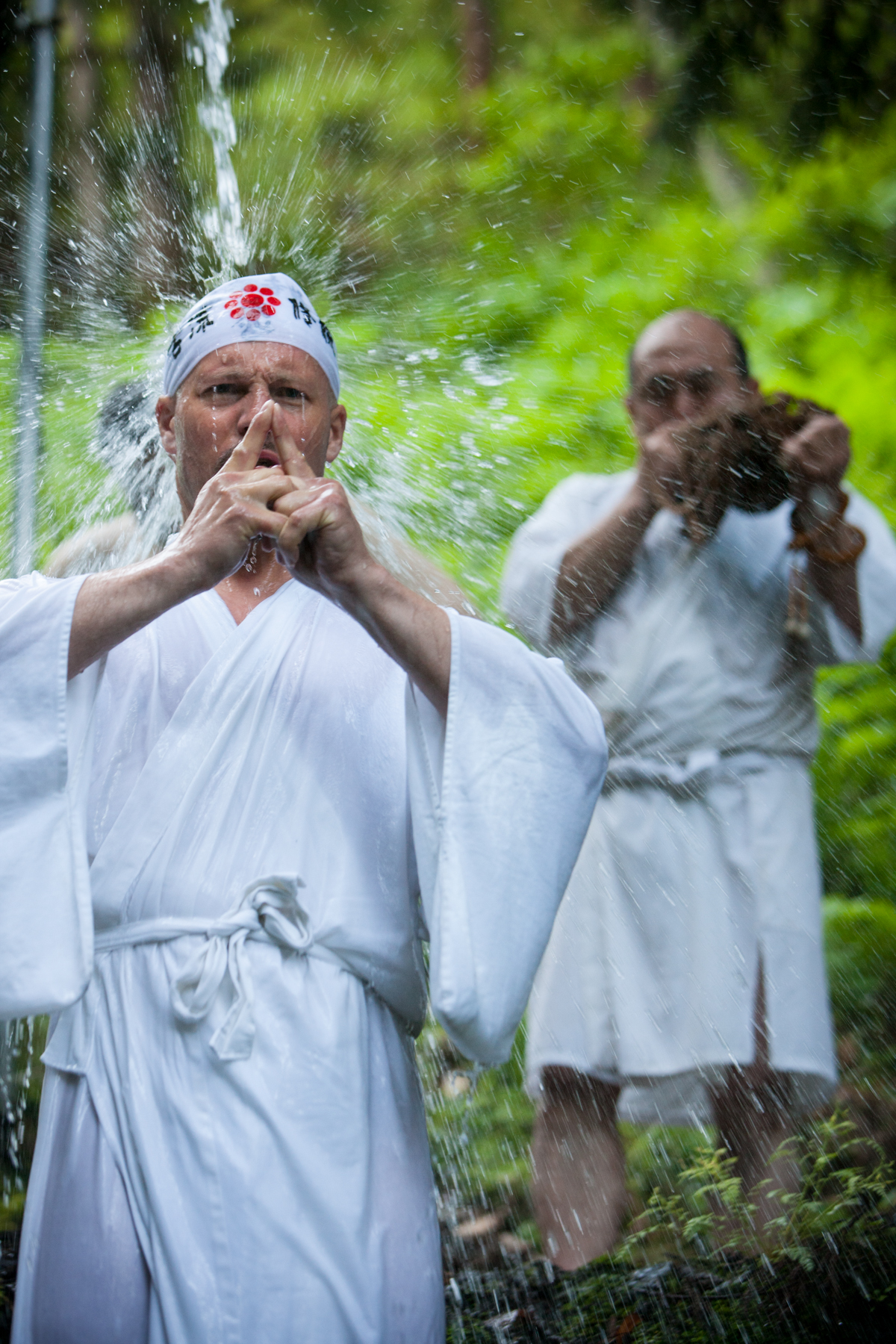
Foreign practitioner, Christian Grubl, performs a misogi rite with a shugendo group

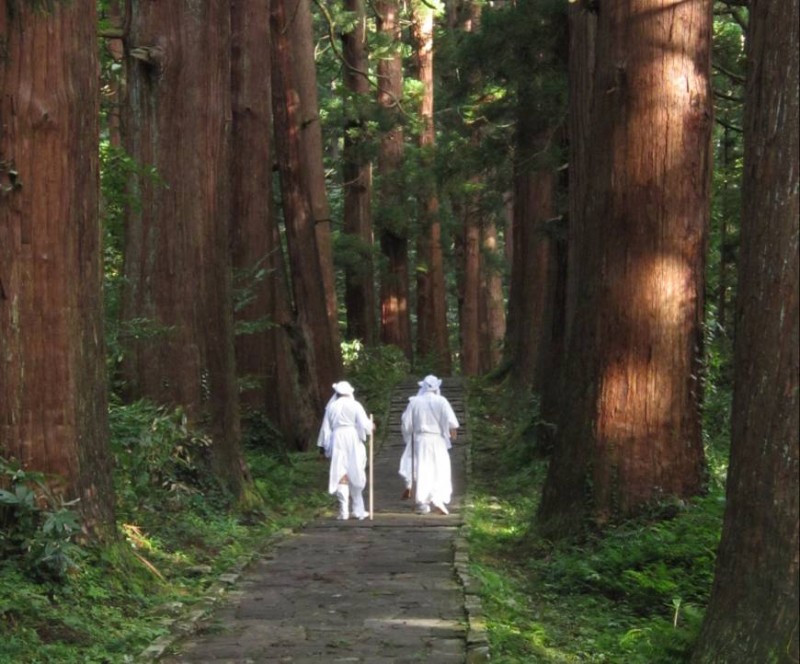
Thank-your for sharing the article John. Over the last few months I’ve seen numerous references to the yambushi associated with Dewa Sanzen. Their outreach is impressive. This article stands out in the evocative way it is written. Hearing the perspective of a non-yamabushi helps those of us wearing the same boots. Recently I’ve had the privilege of spending time with a Shugendo group based near Lake Biwa. Both of my experiences with them were associated with Shrines. While I know that Shugendo is a highly syncretic religion, this was unexpected. It shows that I have much to learn! Finally, the reference in the article to the Sky Tree was interesting. The construction had been criticised because of bad Fusui (Feng shui), being likened to a poison arrow. The architects response was that the Sky Tree represents a five element pagoda that would protect the prosperity of Tokyo for years to come. I hadn’t heard that it was based on the Dewa Sanzen pagoda. You learn something new every day!
Thanks for that, Jann. The Shugendo group near Lake Biwa sounds of great interest, and I’d like to hear more about that. I wonder if your experience happened to take place at a shrine, which is common enough, or if the group is officially attached to a Shrine? If so, that would be unusual in my experience, for they nearly always seem to be attached to an Esoteric Buddhist sect, namely Shingon or Tendai.